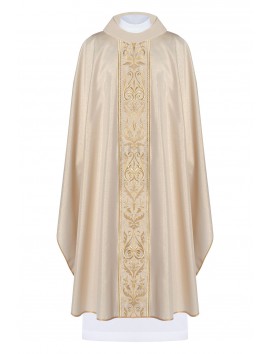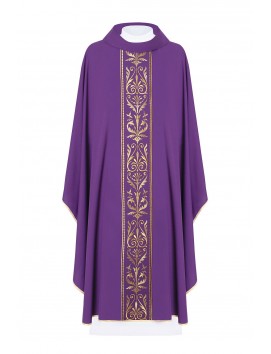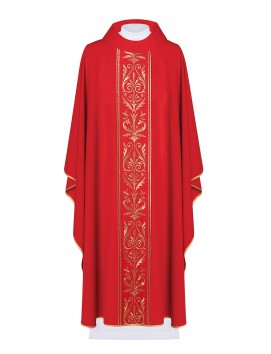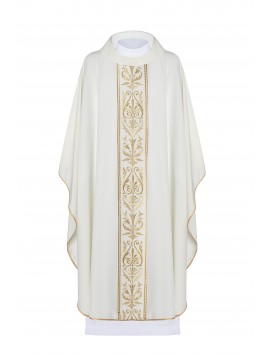The Roman chasuble has a rich history and symbolism in the Roman Catholic Church, spanning centuries of spiritual significance. This blog post will explore the historical context of Roman chasubles, their symbolism through design and ornamentation, as well as the role they play in modern times. From the practical role played by these vestments to the deeper meaning held within, this post will bring to light an often overlooked but important part of the Catholic tradition.
Introduction
The Roman chasuble is a garment of great significance in Christianity that has a long history and rich symbolism. Its origins go back to the early days of the Roman Empire when it was used as part of religious services, and today it remains an enduring symbol of both ritual and faith. In this blog post, we'll explore the history and symbolism of the Roman chasuble in detail, as well as how it continues to be used in churches around the world.
Historical Context Of Roman Chasubles
The modern Roman chasuble is an outer garment traditionally worn by the clergy during liturgical celebrations. Its use can be traced back to the vestments of ancient Rome. These distinctive garments, which were typically made of a long, sleeveless robe that was tightly fitted around the neck and arms, served as a symbol of purity and holiness for its wearers. The traditional colours associated with these chasubles reflected their larger spiritual significance - white for joy, gold for glory, red for love and purple for humility - each signifying important elements within Roman Catholic worship. Over centuries, the design of these pieces has evolved somewhat but still remains strongly rooted in its historical context - providing us with insight into this rich piece of religious history.
Chasuble Symbolism In The Roman Catholic Church
The chasuble is a garment worn by Roman Catholic priests in the celebration of the Eucharist. Symbolically, it represents charity and Christ's sacrifice on behalf of humanity. The color of the chasuble also holds great significance in Roman Catholicism. White is worn during Christmas, Easter and Christmastide, while green denotes Ordinary Time; purple is reserved for Lent and Advent; red marks special feast days such as Pentecost or Holy Week; black is used to represent mourning or sorrow; and rose may be worn to represent joy during Gaudete Sunday or Laetare Sunday. As a vestment, the chasuble embodies both Catholic tradition and a deep spiritual meaning that has been passed down through generations.
Design And Ornamentation Of Roman Chasubles
The design and ornamentation of Roman chasubles has been used to communicate religious messages for centuries. Richly decorated with woven fabrics, embroideries, and figurative designs, the chasuble is a unique form of liturgical vestment that carries a significant meaning in the Catholic Church. The overall shape of the garment tends to be wide and simple - usually a single large piece that's draped over the shoulders and falls almost to the feet. Its decoration can range from traditional Greek crosses, floral motifs, and stylized letters, as well as vivid colors that symbolize Christ’s Passion. Ornamental elements such as inscriptions on bands or ribbons are often seen on well-crafted chasubles. Additionally, some may contain intricate details denoting specific meanings about Jesus Christ’s mission or an individual saint’s identity. All this combined makes it a remarkable garment with much symbolism embedded within its design!
The Role Of Roman Chasubles In Modern Times
Roman chasubles are an integral part of Christian liturgical wear, originating in the Roman Catholic Church as far back as the 4th century. Although their overall design has evolved, they remain a key symbol of Christianity's long and illustrious history even today. Modern Roman chasubles are usually ornately decorated with symbols such as crosses and other Christian motifs, and they continue to be worn by priests during services. In addition to providing spiritual significance and a connection to the past, Roman chasubles can be found in various forms to suit a variety of styles and preferences. Their traditional use within religious ceremonies is still pertinent today, but they may also be collected as decorative pieces or used for fashion purposes by those interested in paying homage to Christian Roots.
Conclusion
In conclusion, the Roman chasuble is a true symbol of veneration and reverence that has long been admired and utilized in the Christian religion. Its rich history is entwined with ancient symbols and rituals that still have relevance today. From its evolution over the centuries to its unique fabrics and designs, it remains a powerful symbol of faith for millions of people worldwide. Whether you’re wearing it as part of a religious ceremony or simply admiring its beauty, this timeless garment is sure to bring admiration and respect wherever it goes.




















